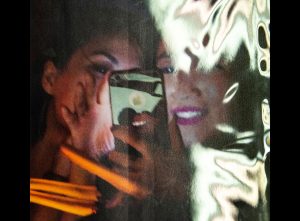
Bernard Langerock
Fotografie & Installation
05.11.2021 –19.12.2021
Eröffnung der Ausstellung: Fr. 05.11.2021 | 19 h
Künstlergespräch mit Bernard Langerock und Hella Nocke Schrepper: So. 07.11.2021 | 15 h
Opening hours: Wed.– Fr. 14 –19 h | Sa. 15 –18 h
Bernard Langerock is fascinated by light reflections. Depending on the type of surface the light hits on, it reflects back in different qualities; think of the texture of water surfaces, Asian lacquerware, shop windows and other glass surfaces. Moreover, Langerock is enthusiastic about the idea of not photographing or making a finished image but creating an image that only completes itself when viewed. The wide range of meaning of the English term - from likeness, appearance, representation to imagination - gives a first hint at a much broader and more complex concept of image, which also refers to an immaterial aspect of photography. The location of the images is neither the event depicted, nor the camera as a fixing apparatus or the viewing eye as a sensory organ. It is the interplay of an individual experience of time and space, which is not the result but the beginning of awareness.
In exhibitions, photographs are usually presented behind UV glass in such a way that possibly no reflections cloud the viewing. Bernard Langerock takes a completely different approach here, having conceived his images at the time they were taken and their subsequent hanging in such a way that reflections inevitably arise in them and the immediate surroundings and the viewer himself becomes part of the image.
The series “Erst vor Ort”, created in year 2021 under the influence of the Corona pandemic, features portrait studies, including those of Joseph Beuys and Timm Rautert, that Langerock took during visits to museums and exhibitions that have become rare. Other studies show a laughing woman in Shanghai and smoking teenagers in Chongqing. The reflections on and at the same time in the images act like a gesture, like a partial overpainting that connotes the image contents and thus enriches them with additional meanings. They give the images a coloring.
Die Reflexionen auf und zugleich in den Bildern wirken wie eine Geste, wie eine partielle Übermalung, die die Bildinhalte konnotiert und sie so mit zusätzlichen Bedeutungen anreichert. Sie geben den Bildern eine Färbung.
Langerock’s photographs are pictorial and physical approaches to historical and contemporary photographs and raise the question of how we ourselves relate to images of reality and thus create our own realities. Thus, the work labels of the individual works also make clear when and where the original photographs were taken, when they were exhibited, and when they were photographed in turn. In this way, we become indirectly aware of how an image is transformed through time, but only becomes comprehensible and graspable on site.
Tobias Chriske
